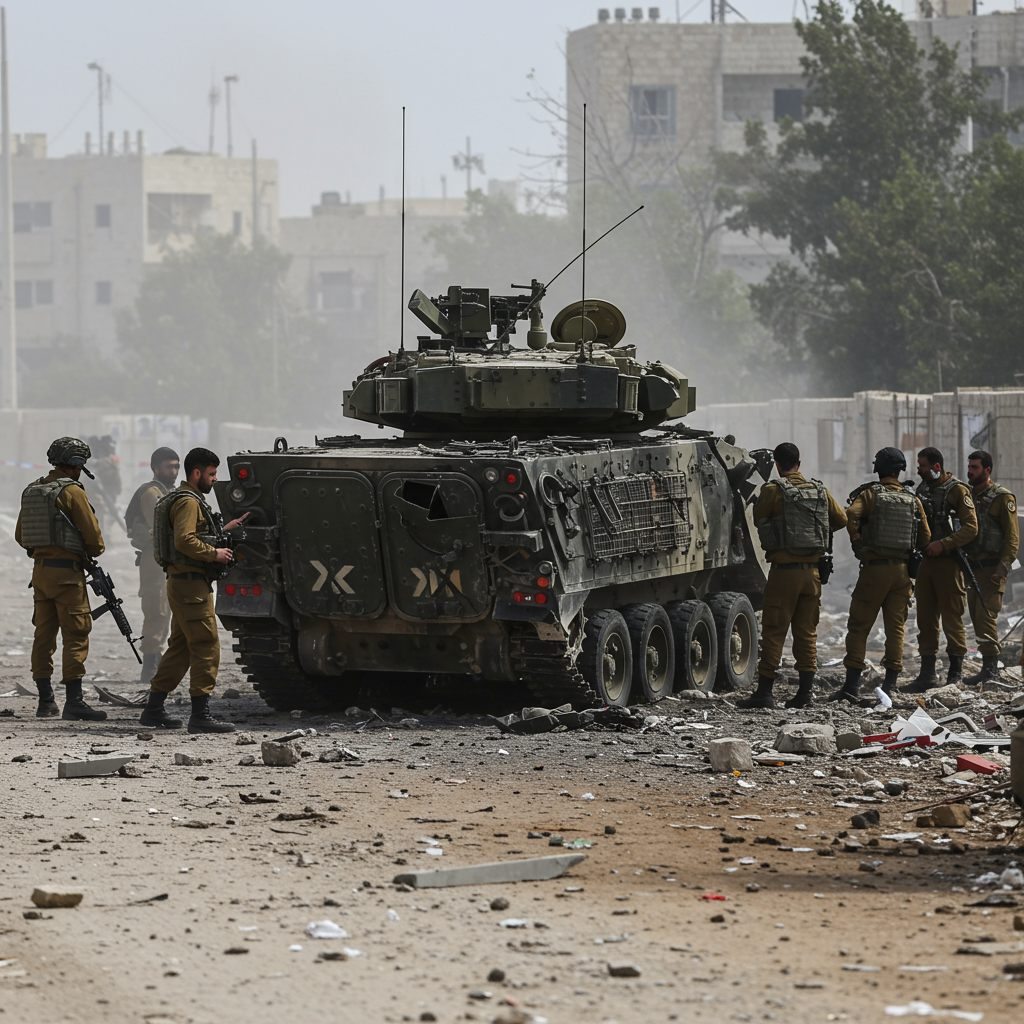The fragile peace in the Middle East shattered this week as Israeli Prime Minister Benjamin Netanyahu ordered “immediate, powerful” military strikes against targets in the Gaza Strip. This dramatic escalation followed accusations by Israel that Hamas had flagrantly violated a US-brokered ceasefire agreement. The core of the dispute centers on allegations that Hamas not only attacked Israeli forces but also engaged in a deceptive act, staging the discovery of deceased hostage remains to mislead international observers. This new round of violence has plunged the region back into deep uncertainty, threatening to unravel critical diplomatic efforts.
Escalating Tensions: Israel Accuses Hamas of Ceasefire Breaches
On Tuesday, Prime Minister Netanyahu concluded urgent security consultations by issuing a directive for forceful retaliation in Gaza. His office released a concise statement confirming the military echelon had been instructed to carry out “immediate, powerful strikes.” This decision was promptly communicated to US officials, underscoring the gravity of the unfolding crisis. Israel’s Defense Minister, Israel Katz, issued a stern warning, asserting that Hamas would incur a “heavy price” for its actions and vowing a resolute response from the Israel Defense Forces (IDF).
The immediate triggers for this renewed offensive were multi-faceted. Israeli officials accused Hamas of directly attacking IDF troops positioned east of the “yellow line,” the unofficial boundary separating Israeli-occupied Gaza. Compounding this, a more contentious claim emerged: Israel alleged Hamas had deliberately orchestrated a deceptive handover of human remains, attempting to pass off a body that did not belong to any of the 13 Israeli hostages still unaccounted for.
The Hostage Remains Controversy and Allegations of Deception
A central point of contention fueling Israel’s fury was the alleged manipulation surrounding the return of hostage remains. According to Israeli forensic testing, partial remains transferred by Hamas belonged to Ofir Tzarfati, an Israeli hostage whose body had already been recovered during an IDF operation in November 2023. Tzarfati was among the 251 individuals abducted by Hamas and Islamic Jihad during the devastating October 7, 2023, attacks, which also claimed 1,200 Israeli lives. Israel labeled this act a “clear violation” of the standing agreement.
Further evidence, according to the IDF, came in the form of drone footage. This nearly 15-minute video, released by the military, purportedly shows Hamas operatives burying a body, wrapped in a white shroud, in a bulldozed plot in Gaza City. Moments later, the video allegedly depicts the same operatives staging its “discovery” in front of Red Cross officials, with someone even appearing to film the scene on a cell phone. This was presented by Israel as an attempt by Hamas to “create a false impression of efforts to locate the bodies” of deceased hostages, potentially fabricating evidence of their cooperation. The Israeli Ministry of Foreign Affairs explicitly stated, “Hamas lies. They know where the remaining hostages are. Staged excavations are not only abusive — these violations endanger the ceasefire.” This alleged deception reportedly infuriated hardline members of Netanyahu’s Cabinet, with Finance Minister Bezalel Smotrich urging the prime minister to “rearrest all the terrorists who were released in the hostage deal.” This refers to the prior release of 250 Palestinian prisoners and 1,700 Gazan residents as part of the broader peace plan.
Hamas Responds: Denials and Counter-Accusations
In the wake of Netanyahu’s order, Hamas swiftly responded with strong denials and counter-accusations. The militant group vehemently rejected Israel’s claims of wrongdoing and ceasefire violations, accusing Israel of attempting to “fabricate false pretexts” to justify new military aggression in Gaza. Hamas officials maintained that any Israeli escalation would inevitably “hinder search and excavation operations and the retrieval of bodies” of deceased Israeli hostages.
The armed wing of Hamas also announced an immediate postponement of its planned handover of a hostage’s body, which had been recovered in southern Gaza earlier that Tuesday. Hamas indicated that this body was unearthed in Nuseirat, central Gaza, from the rubble of a building where Israel had conducted a rescue operation in June 2024, an operation that freed three Israeli hostages. While Israel and the US had denied Hamas’s prior claims that other hostages were killed during that mission, geolocated footage of the recovery site raised fresh questions about those assertions. The Palestinian Ministry of Health reported over 270 Palestinians killed and hundreds injured in the June rescue operation. Hamas further alleged that the IDF had violated the ceasefire 80 times and killed over 80 Gazans since the agreement took effect two weeks prior. Amid the strikes, Hamas also claimed to have unearthed another hostage’s body but stated it would not return it.
The Shaky Foundations of the US-Brokered Ceasefire
The immediate consequences of Netanyahu’s order were palpable across Gaza. Residents were observed rushing home, and shops closed prematurely as explosions rocked Gaza City, particularly near Al Shifa hospital. At least two deaths were reported, amplifying the pervasive atmosphere of anxiety and exhaustion among the population, according to local reports. The ceasefire, in effect since October 10, was a delicate agreement brokered by the administration of former President Donald Trump. Its primary goals were to facilitate the release of hostages and enable the withdrawal of Israeli troops from certain areas of Gaza, aiming to halt what the Washington Examiner described as “two years of conflict in the Strip.”
The terms of the deal stipulated that Hamas would release 20 surviving Israeli hostages (which it had done) and the remains of 28. In exchange, Israel was to return the bodies of 15 Palestinians for every deceased Israeli handed over. However, officials in Gaza have also claimed breaches from their perspective, alleging that Israel provided unidentified and mutilated remains, some of which were buried in a mass grave. This latest breach marks the second major violation of the ceasefire in three weeks, raising significant fears for its complete collapse despite a US official reportedly telling Al Jazeera that the “overarching agreement” was still expected to hold. The US reiterated its commitment to overcoming challenges to achieve stability, civilian rule, and tangible progress toward peace in Gaza.
Broader Regional Instability and West Bank Escalation
The renewed violence in Gaza is not an isolated incident but reflects broader regional instability. Concerns have intensified regarding Israeli actions in the occupied West Bank as well. On the same Tuesday, Israeli forces shot and killed three Palestinians—Abdullah Jalmana, Qais Al Bitawi, and Ahmed Nashti—during a raid in the village of Kafr Qud near Jenin. The Palestinian Health Ministry and news agency Wafa reported that Israeli forces stormed the village, besieged farmland, shot the men, and bombed their vehicle, which also ignited olive trees. The Israeli military, however, stated that its troops identified a “terrorist” cell inside a cave, engaging and “eliminating” three militants as they emerged. Defense Minister Israel Katz lauded this operation and vowed to crush any extremist group’s attempts to rebuild infrastructure “with an iron fist,” ordering all necessary measures in the West Bank. Hamas condemned the incident as part of a “systematic policy of field killings” and “bloody crimes.”
This increased violence in the West Bank reflects a trend since the Gaza war began two years ago, with Israel having launched a large-scale campaign to suppress Palestinian armed groups in northern West Bank refugee camps. This has led to the displacement of tens of thousands of Palestinians and the demolition of dozens of homes and buildings. The concurrent escalation in both Gaza and the West Bank highlights the severe fragility of the ceasefire and the deepening conflict across the Palestinian territories, challenging any immediate prospects for lasting peace.
Frequently Asked Questions
What were the immediate triggers for Netanyahu’s order for strikes in Gaza?
Prime Minister Netanyahu’s order for “immediate, powerful” strikes was primarily triggered by two key Israeli accusations against Hamas. First, Israel claimed Hamas attacked Israel Defense Forces (IDF) personnel in southern Gaza. Second, and more critically, Israel accused Hamas of violating the ceasefire by staging the discovery of deceased hostage remains and returning incorrect identification. Specifically, partial remains were identified as Ofir Tzarfati, whose body was already recovered in 2023, constituting a “clear violation” of the agreement.
What role did the Red Cross play in the controversy surrounding the hostage remains?
The Red Cross was involved as the intended mediator for the handover of hostage remains from Hamas to Israel. However, the controversy arose when Israeli drone footage allegedly showed Hamas operatives burying a body and then staging its discovery for Red Cross officials to witness. Israel claimed this was a deceptive attempt by Hamas to create a false impression of cooperation in locating deceased hostages, rather than an authentic discovery. Hamas, in turn, announced it would postpone future transfers via the Red Cross due to the Israeli strikes.
How does this latest escalation impact the broader US-brokered peace plan in the region?
This renewed escalation significantly threatens the US-brokered peace plan, which had established a ceasefire just weeks prior. The plan aimed to facilitate hostage releases and IDF withdrawals, following two years of conflict. While a US official expressed hope that the “overarching agreement” would still hold, the mutual accusations of ceasefire violations—especially over the sensitive issue of deceased hostage remains—demonstrate extreme fragility. The increase in violence in both Gaza and the West Bank undermines trust, impedes diplomatic efforts, and makes the transition to “permanent peace in Gaza” even more challenging.
Conclusion
The latest eruption of violence in Gaza, instigated by Prime Minister Netanyahu’s order for “powerful strikes,” marks a perilous turning point in the US-brokered ceasefire. Accusations of Hamas violating the truce, particularly through the alleged staging of deceased hostage discoveries and direct attacks on IDF troops, have shattered a fragile period of calm. While Hamas vehemently denies these claims and levies its own accusations against Israel, the reality on the ground is one of heightened tension, humanitarian concerns, and a deepening cycle of conflict. The path to lasting stability in the Middle East remains fraught with immense challenges, demanding persistent diplomatic engagement and a renewed commitment from all parties to de-escalate and rebuild trust.




